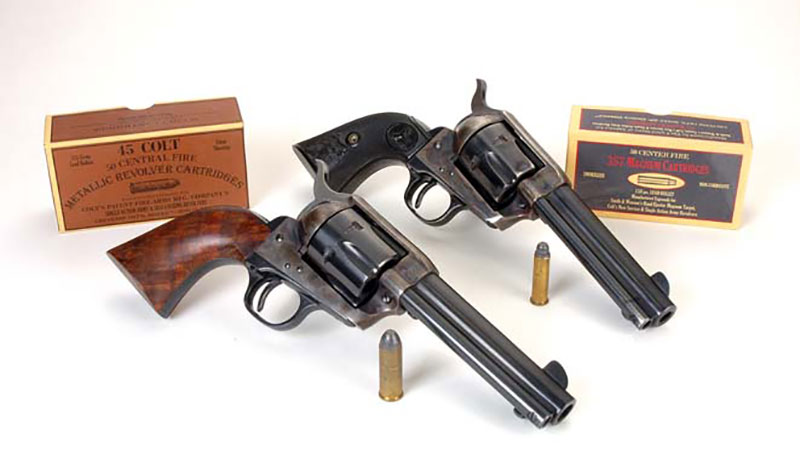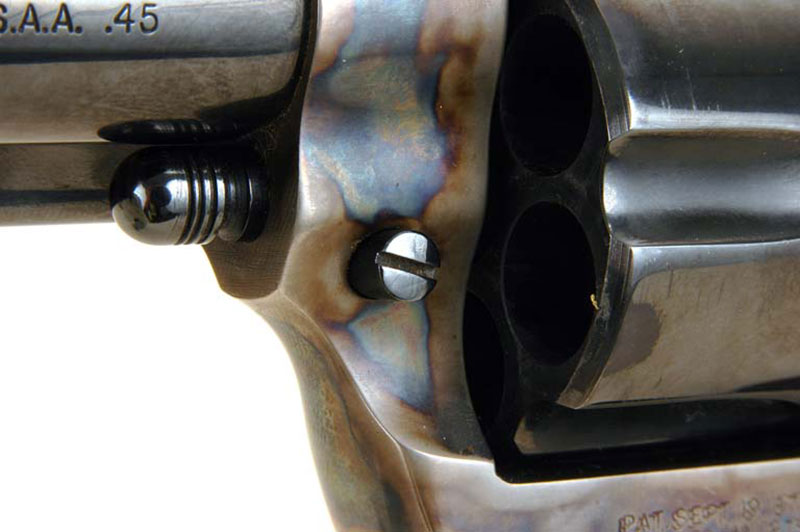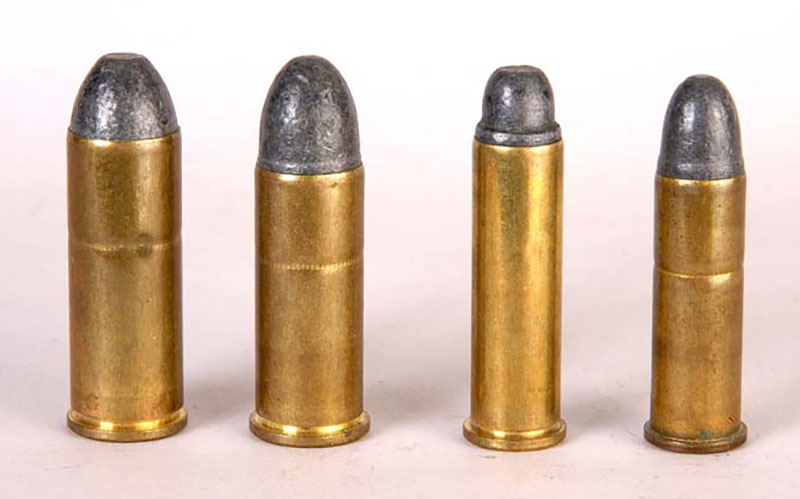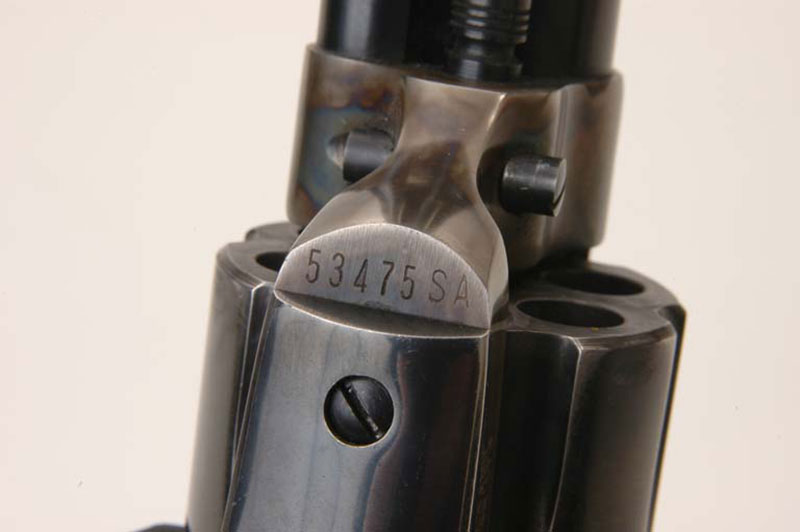The Second Generation
Colt SAA
Part 9 Of A 12 Part Genesis Of The Colt Single Action
In the last few years of 1st Generation SAA production only about 100 were shipped every 12 months. Then World War II brewed up requiring all of Colt’s production capabilities for military weapons. Therefore, it was natural that Colt’s post-war hierarchy felt the fine old Peacemaker was a thing of the past.
They weren’t considering the new phenomenon of television. Anyone who lived through the decades of the ‘50s and had a TV must remember the vast assortment of western programs. I certainly do. There were far too many to detail here but it is safe to say in the holster of each and every one of those “little-screen” stars there resided a Colt SAA revolver. In fact I can’t remember ever seeing either a good-guy or bad-guy with anything but a Peacemaker.
No wonder then that the firearms collecting fraternity and just about every TV watching kid focused on the Colt SAA revolver almost totally to the exclusion of every other Old West handgun. No wonder also that keen minds at Colt saw sales opportunities, and therefore in 1956 reintroduced the SAA. There were virtually no changes in the model from the last ones made circa 1940. In fact Colt merely pulled the tooling from storage to begin production. However, instead of taking up where serial numbers left off 15 years before they started again plus added an SA suffix as in 0001SA.
Naturally the initial chambering offered was .45 Colt, but in the latter half of the 20th century gun buyers’ tastes in calibers had changed. The popular but obsolete .32, .38 and .44 WCFs (Winchester Centerfires) were not offered. Instead, later in 1956 .38 Special became a standard Peacemaker caliber. Interestingly, in 1st Generation production, only 25 had been made as .38 S&W Specials with another 82 made as .38 Colt Specials. Those were merely different names for the same cartridge.
1958
In 1958 Colt added .44 Special to the list, with .357 Magnum coming along in 1960. Again it’s interesting to note in the first run, only 506 had been chambered for .44 Special, and 625 for the magnum. Standard barrel lengths remained 4 ¾”, 5 ½” and 7 ½”, but for some strange reason you couldn’t buy a .44 Special with the shortest barrel length. A special run of only 503 SAAs were made in .45 Colt caliber with 3″ barrels. Their frames were different too in that no provision was machined on them for mounting ejector rods and housings. Most probably for no historical reason, these short SAAs were named Sheriff’s Models.
In the late 1950s one of those popular western TV shows was named Wyatt Earp. It was a fictionalized account of that man’s career as a law enforcement officer in Dodge City, Kansas. On screen the actor wore a Colt SAA with extra- long barrel. These were called “Buntlines” after a dime novelist of the 1870s named Ned Buntline. The story goes that Mr. Buntline had Colt make up some special SAAs with extra-long barrels which he then presented to a few frontier peace officers, with Wyatt Earp being one recipient. Whether the story is true or not, these 2nd Generation Colts with 12″ barrels were labeled Buntline Specials. About 4,000 were made in the 2nd Generation run and speaking personally, I think no more awkward version of Colt SAA was ever made.
Finishes
As with the first run of SAAs the 2nd Generation ones were finished either full nickel-plated or blued with color case hardened frames. Most 1st Generation hammers were also case hardened, but toward the end of production they started having bright polished sides. So did all 2nd Generation hammers. Grips were also the same as those with which 1st Generation Peacemakers stopped: hard rubber, two piece types. Reflecting the television program influence, circa 1960 Colt quit shipping SAAs in simple black boxes and came up with a colorful one that came to be known as “Stagecoach Boxes.” Of course that was because there was a drawing of one on its top.
Second generation sales started out gangbusters, then slowly declined through the 1960s. For instance the first two years 8,800 and 9,900 were made, but then in ’64 and ’65 only 1,200 and then 1,500 were shipped. Sales picked up in the early ‘70s with 6,800 made in ’71 and about 5,000 in ’74. That was the year Colt quietly let production cease for the second time. Their tooling was worn from decades of manufacturing, and also costs of production were rising. Colt took a couple years recess to make more jigs and fixtures, and also to redesign the revolver in order to cut manufacturing costs. That’s where we’ll take up with the next installment, the 3rd Generation.
However, to finish up I’d like to put some comments in about my personal involvement with 2nd Generation Peacemakers. That started the first week of June 1968 when I bought, for the sum of $100, a used but beautiful condition 2nd Generation .45 with 5 ½” barrel. When I foolishly sold it nine years later it bore the scars of my learning experience in the form of severely buggered screws along with plenty of scratches, blue wear, and faded color case hardening.
In May of 1970 I turned 21 and could walk into a gun store and legally buy a handgun for the first time. That I promptly proceeded to do at a place called Mack & Dave’s in Huntington, West Virginia. In the case there were several brand new 2nd Generation SAAs in their fancy stagecoach boxes. My mind was set on one with a 4 ¾” barrel and they had one in both .357 Magnum and .45 Colt calibers. As I drove to that store, only a .45 Colt was in my head. Then upon arriving and discovering the .357 option I agonized between .45 and .357 until about five minutes prior to closing. I decided on the latter.
As is common when a plan is changed at the last minute that choice was a mistake. I regretted it for many years. The reason was that smaller caliber SAAs don’t have the same heft and feel of the big bores. I was never “in love” with that .357, which is probably the reason I sold it in 1972. I bought it back in 1976, sold it again in 1977, and then finally bought it a third time in 1996. All the while I had kept the original stagecoach box so now the two are together and will remain so throughout my lifetime. It took a while but my eventual remedy was to get a 2nd Generation .45 with 4 ¾” barrel as I should have bought in the first place.
Many other 2nd Generation Peacemakers have come and gone in these past decades, but the two detailed above were instrumental in launching me on my life’s career.
Click Here To View List And Links To All Colt Series Articles












